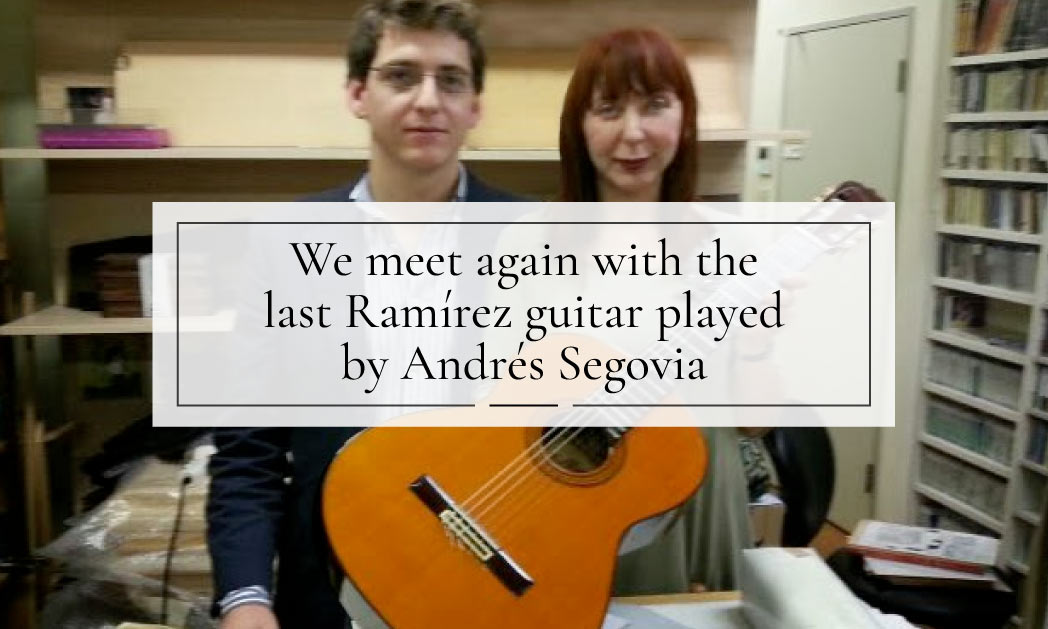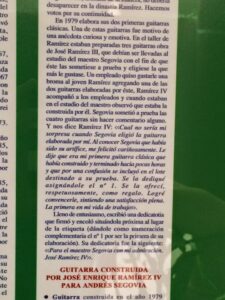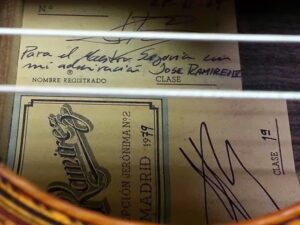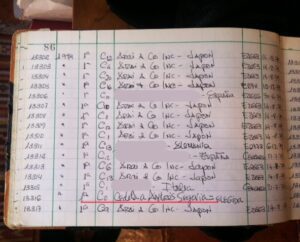March 14th 2013 has been set as a memorable date, a day to celebrate in Casa Ramírez. And if I am especially keen on telling this story, it is because I’ve lived it myself from the beginning, step by step, until nowadays, leaving delicately aside the years it implies I have.
But let’s start from the very beginning, or from one of the beginnings of this story that has its roots in the year 1912, the day my great-grandfather’s brother, Manuel Ramírez, gave this legendary guitar to the then unknown Andrés Segovia. That was his first Ramírez. The one that is displayed in the MET under the specific condition is not played by anyone.
The guitar built by Ramírez IV that came into the hands of Andrés Segovia
In the year 1979, my father, as was customary, had done a selection of several guitars that gathered certain characteristics that filled the preferences of the master, and they were sent to him to choose the one he liked the most. And not knowing that one of them had been constructed by my brother, Ramírez IV (at that time all the guitars had my father’s signature on the label), the master chooses precisely this guitar.
When he knew it, my brother felt such happiness, that breaking the rules of the house, he personalized it by writing a dedication in his hand, he signed and glued it next to the label, and of course, he gave it to him for free.
I remember quite well the day my brother was given the news, because for him that was the best test he could pass as a guitar maker, even more, significant than the day when he presented my father with the guitar he had done and that meant obtaining the category of the first official. His guitar had been chosen by Andrés Segovia. That was a great award.
We knew that he was playing this guitar in his concerts all over the world until the end. Not long ago my distributor in Japan, Shiro Arai, told me that he organized the last concert of Segovia in Japan, and he had played this guitar. Actually, this is well known, so we are not going to extend on that. It’s enough just to say that this was the last Ramírez that belonged to Segovia, whose career with Ramírez started and ended with a present made with all our hearts.
After Segovia died in 1987, we didn’t have any more news about this guitar. Until the day when Pepe and I had gone to Frankfurt’s Fair, a friend called us, he was a string maker, and he came running from his stand to greet us shaking a magazine in his hand. I can’t remember very well if it was the year 1997 or 1998, and sadly, I can’t remember either what the magazine was. What I recall is that the happiness of our friend was due to the article he showed us. In it, there was a picture of the guitar my brother had given to Andrés Segovia, with its dedication, and with the news that it had been acquired by a great admirer of the master and Ramírez guitars.
It mentioned the quantity they had paid for it but not the name of the purchaser. My brother felt conflicting emotions when he heard the news, on the one hand, he was happy because the guitar had fallen into the hands of someone who would appreciate it, on the other hand, he felt sad when he remembered the absence of the master, since he, the same as my father and even me, occasionally, had had a close relationship with the master.
Since that moment, and especially after the death of my brother, I have frequently recalled this story, and I thought I had put an end to it until October 14th 2013. The exact moment I started to write this article.
The trip to Japan led us to the last Ramírez guitar of Andrés Segovia
My nephew José Enrique and I had travelled to Japan, and we were giving a talk in the workshop of the Aura shop, managed by Mr Motoyama in Tokyo. At a given moment of the talk, when I was talking about my brother, I told the story of this guitar. When we finished the talk, several people from the audience approached us to show us their guitars and listen to our opinion on whether the guitars needed any adjustment or not. To our great surprise, a gentleman approached us with the guitar my brother had given to Segovia, with its dedication signed and glued next to the label, and showing us a certificate of its purchase.
I have no words to describe the expression of my nephew while he held this treasure in his hands; you could read in his eyes the emotion and pride he felt for his father, whose he had lost when he was only a child. That was the best present we could receive on this journey, and sincerely, in a long time since I manage this familiar business.
We were told that the owner of the guitar, having known that my nephew and I were in Aura this day, had done a long trip to show us the guitar, proud as well as expecting to know what we could tell him about it. Although we didn’t know, for him it was also a surprise that we told the story of the guitar, that because of him, I can now complete, although, who knows? Maybe I write some other chapter related to it. Such a beautiful story deserves to go on growing.
When I came back to Madrid, I could check the guitar’s serial number, proving one more time that it had been transferred to the master in 1979, the year my brother had constructed this historical instrument. That sets a closure to 75 years since Andrés Segovia played his first Ramírez to his death in full possession of his last Ramírez.
It is a striking detail that this guitar still has a stain of coffee on the side and part of the back, a “medal” that proves that he was probably studying with it while he was having his cup of coffee, a fond detail of his everyday life.
- Text in the Andrés Segovia Foundation
- Amalia and Enrique Ramírez (José Ramírez V) with the guitar made by Ramírez IV
- Guitar programme
- Andrés Segovia with what is possibly the guitar that we talked about in the article
- José Ramírez IV
- Dedication signed by Ramírez IV on the guitar he made and which he gave to Andrés Segovia as a gift.
- Archive of Ramírez Guitars with the serial number of the guitar given to Andrés Segovia by Ramírez IV
Amalia Ramírez
11 November 2013









